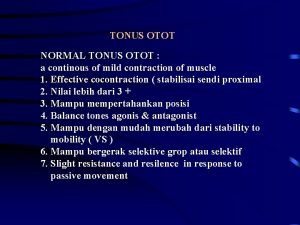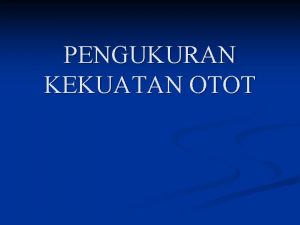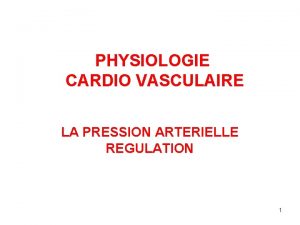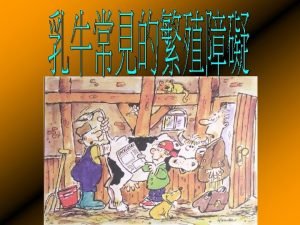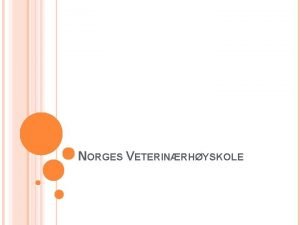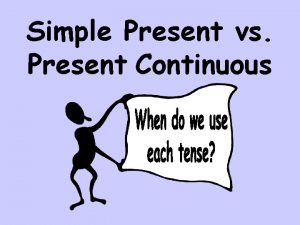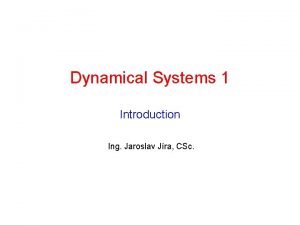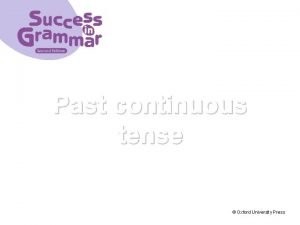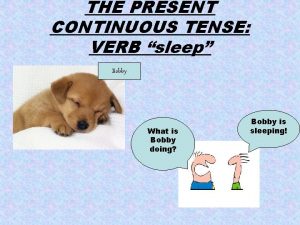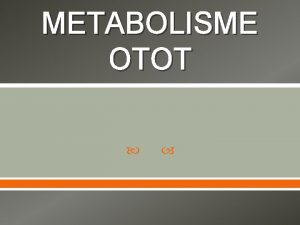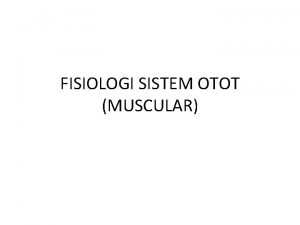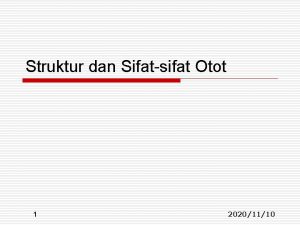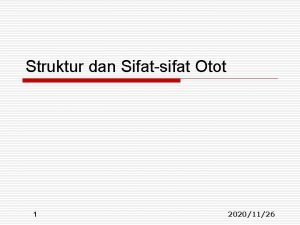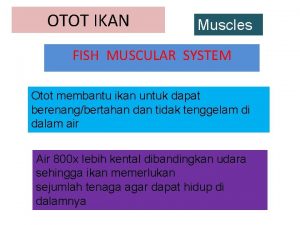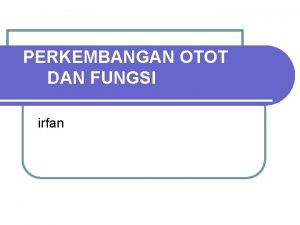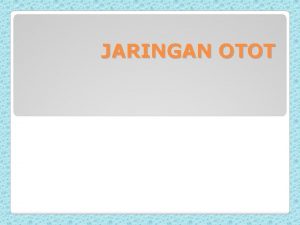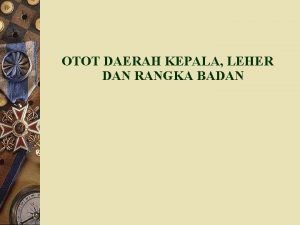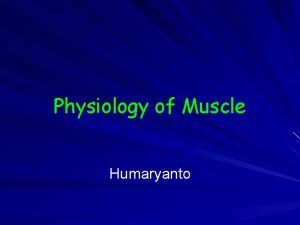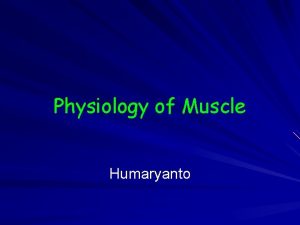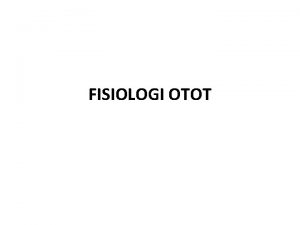TONUS OTOT NORMAL TONUS OTOT a continous of














- Slides: 14

TONUS OTOT NORMAL TONUS OTOT : a continous of mild contraction of muscle 1. Effective cocontraction ( stabilisai sendi proximal 2. Nilai lebih dari 3 + 3. Mampu mempertahankan posisi 4. Balance tones agonis & antagonist 5. Mampu dengan mudah merubah dari stability to mobility ( VS ) 6. Mampu bergerak selektive grop atau selektif 7. Slight resistance and resilence in response to passive movement

FLACCIDITY : hypotonicity ( mild, moderate to severe • 1. Mild Flaccidity – Tonus otot turun, cocontration lemah, – mampu menahan posisi – Nilai otot turun tapi masih dapat melakukan fungsi • 2. Moderate to Severe Flaccidity – – – Penurunan tonus otot yang significant tak ada cocontraction tak dapat menahan posisi minimal or absence to move against gravity Significat loss of strength

SPASTICITY hypertonicity, hyperactive deep tendon reflex, Clonus, abnormal spinal reflex 1. Mild Spaticity 2. Moderate spaticity 3. Severe spasticity

1. Mild Spaticity • mild or weak strech reflex ( Clasp Knife Fenomenon ) • slight decrease of balance tone - agonist vs antagonist • mild increase of resistance of passive strech ROM full • slight decrease of mobility • penurunan kemampuan gerakan selektif / fine movement.

2. Moderate spaticity • moderate stretch reflex • jelas nampak imbalance tone - agonist vs antagonist • considerable resistance of passive stretch ROM full • Gross movement slowly, abnormal coordination 3. Severe spasticity • Strong strech reflex • marked resistance of passive stretch • Tak dapat di full ROM • Joint Contracture • severely decreased of mobility

RIGIDITY increase of muscle tones of agonist and antagonist simultanneously • Lead pipe rigidity Constant resistance occurs passive movement ( ROM VS ) • Cogwheel rigidity Rhythmic give resistance throughout ROM Recording the result of muscle tone 0 moderate to severe hipotonicity 1 Mild hypotonicity 2 Normal tones 3 Mild hypertonicity 4 Moderate hypertonicity 5 Severe hipertinicity

Modifikasi Skala Ashworth • Dengan mengerakan secara pasif anggota gerak sampai ke ROM penuh • Tahanan yang diperoleh melalui gerakan pasif dinilai antara 0 – 4 • Nilai normal adalah nilai 0 • Kesulitan dari tes ini adalah mengulangi gerakan.

Nilai Keterangan 0 Tidak ada peningkatan tonus 1 Ada sedikit peningkatan tonus yang ditandai dengan adanya tahanan minimal pada akhir gerakan 1+ Ada sedikit peningkatan tonus yang ditandai dengan adanya tahanan minimal pada setelah melewati setengah ROM 2 Ada tanda yang lebih tinggi dalam peningkatan tonus yang ditandai dengan kesu; itan menggerakan psif tetapi masih mudah bergerak pada beberapa bagian 3 Ada tahanan nyang kuat sehingga sangat sulit bergerak karena peningkatan tonus yang sangat tinggi 4 Terjadi rigiditas dan tidak dapat digerakan

COORDINATION ability to produce accurate, controled movement Smoothness, Rhythm, approprate speed, minimal muscle appropriaote muscle tension, postural tone, equilibrium Extrapyramidal • Resting tremor Cerebellar dysfungtion • Choreiform movement • ataxia, • Athetoid • adiadochokinesis, • Spasme • dysmetria, • tremor, • Dystonia • Steward Holmes sign, • Ballism • Nystagmus, • Dysarthria,

EVALUASI SENSORI, PERSEPSI, KOGNISI. SENSORI : • Light Touch • Superficial pain • Pressure • Thermal tajam/tumpul ya/tidak > light touch Panas/dingin • Olfactory • Gustatory test penciuman pencecap PERSEPSI • Proprioception • Stereognosis • Body Scheme posisi& gerak bentuk barang mengenal anggota badan

• Spasial jarak • Visual bentuk • homonymous hemianopsiaruang penglihatan • Visual spasial bentuk dan jarak • Unilateral neglect integrasi body scheme & spaisal

KOGNITIF ( konsentrasi problem solving time managemen, conceptualization, komunikasi ) • mampu mengikuti simple /komplek instruksi • mampu mengikuti pelajaran kemarin • mampu berkonsentrasi & perhatian • mampu mengikuti proses bertahap • mampu mengantisipasi dan tahu sebab akibat • mampu memecahkan masalah • mampu merencanakan urutan tahapan ke komplek • mampu mengintepretasikan tanda-tanda dan simbol • mampu memakai hitungan sehari-hari

MEMORI • Menangkap, Menyimpan, Mengingat KALKULASI • perhitungan simple, sampai komplek ABSTRAKSI • membedakan prinsip ( kayu - arang ) FUNGSI PSIKIS • status emosi dan perasaan • coping behaviour • self defence • self identity, self konsep

FUNGSI PSIKOSOSIAL FUNGSI SOSIAL • dyadic interaction • group interaction Ajustment Stage of Physcal Dysfunction 1. Shock : ‘This isn’t me ‘ 2. Expectancy of recovery: ‘ I am sick but I’ll get well’ 3. Mourning : ‘ All is lost ‘ 4. Defensive - Healthy - pathologycal 5. Adjustment “ It is deiferent but not bad “
 Tonus otot normal adalah
Tonus otot normal adalah Tonus otot normal
Tonus otot normal Pengukuran mmt
Pengukuran mmt Barorécepteur et chémorécepteur
Barorécepteur et chémorécepteur Uterine tonus
Uterine tonus Tonus uteri
Tonus uteri Ejemplos de past perfect
Ejemplos de past perfect Permanent situation present simple
Permanent situation present simple Present perfect progressive passive form
Present perfect progressive passive form Wh questions in past continuous
Wh questions in past continuous Continous
Continous Past continuous tense questions
Past continuous tense questions Past simple continuous
Past simple continuous Present simple vs present continuous (1)
Present simple vs present continuous (1) Tenses for sleep
Tenses for sleep
